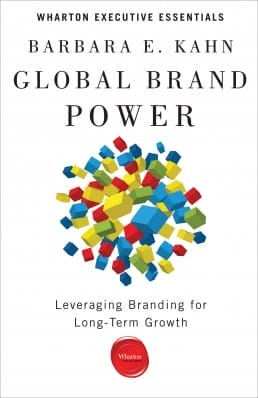Strong brands are more than globally recognizable. They are critical assets that can make a significant contribution to a company’s bottom line. In her latest book, Global Brand Power: Leveraging Branding for Long-Term Growth, Barbara E. Kahn, Wharton’s Patty and Jay H. Baker Professor and director of the Jay H. Baker Retail Center, provides 21st century guidance on how to manage, grow and assess a brand’s value. Below is an excerpt:
Brands today must be global. They must offer value across different countries and diverse cultures: that is, they must be porous enough to allow for reasonable brand and product-line extensions, broad enough to change with dynamic market conditions, consistent enough so that consumers who travel physically or virtually won’t be confused, and precise enough to provide clear differentiation from the competition.
In this age of total transparency— one slip-up can go around the world via social media instantaneously—a strong global brand must express the same core meanings regardless of the market it is in. If those core meanings are not stable across markets, the authenticity of the brand is threatened. Consumers who travel virtually or physically will be confused, and the brand will lose its power. But brands and products are not the same thing. While brands must be global, products introduced to new markets should be implemented with a clear understanding of the local culture and conventions, and advertised, distributed and priced with local market conditions in mind.
The distinction between brands and products became clear in 1985. Brands had existed before then, but neither customers nor marketing managers genuinely understood their true power or realized that they had a life of their own independent from the products’ attributes. Almost without exception, pre-1985 brands were product focused. Think Coca-Cola, Gillette, Nabisco, Campbell, Lipton, Goodyear, and Kellogg. Each one of these was—and still is—a very, very strong brand, but each one also, at least initially, was identified with specific product attributes, which limited growth potential and global credibility.
Then, in 1985, the Coca-Cola Company introduced New Coke and removed what the company subsequently called Classic Coke from store shelves. There were good market reasons for developing the new product. Coca-Cola was a much bigger global company than Pepsi Cola, thanks to Coke’s global expansion and domination of the restaurant and vending machine markets. However, the market share of Coca-Cola was lagging in supermarkets, the only channel where consumers could choose for themselves. Pepsi Cola had launched the “Pepsi Challenge” advertising campaign, which suggested that consumers preferred the taste of Pepsi to that of Coke. In response, after significant market testing, Coca-Cola launched New Coke, which had a product taste that consumers seemed to prefer in blind taste tests. When Coca-Cola executives removed Classic Coke from the shelves, they removed more than a product; they took away something dear to their customers’ hearts. Subsequent market research revealed that consumers felt betrayed. This shocking reaction proved to Coca-Cola and the world that consumers were loyal to brands in and of themselves, and not necessarily to product features. This realization radically changed the way both academics and business practitioners thought about brands. Now, more than 25 years later, we have amassed significant knowledge about how branding works.
We have learned how to build such brands, how to position them appropriately, how to create emotional bonds and how to continually reposition these brands to keep pace with changing market dynamics. Bottom line: We now know how to leverage and manage brands to help the firm grow. Good brands are not accidents. Their long-term value to the firm has to be developed and managed over time. The best brands form relationships with their customers. In doing so, brand meanings may also be co-created through social media communities and customer-engagement strategies. Grappling with all these issues is the challenge that every marketer faces.
Editor’s note: Reprinted by permission of Wharton Digital Press.

























